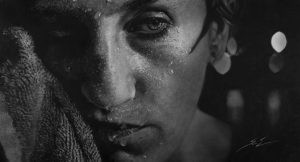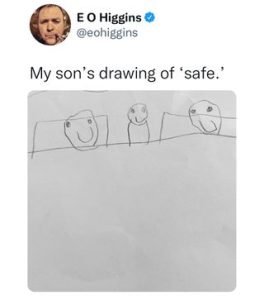Lois Rosson’s essay on AI arts was engaging, interesting, and brought up interesting perspectives. I appreciated the photography example, as I find it very relevant to the subject, and I haven’t seen that point made yet.
I see the perceived quality of art as 2 distinct categories. The first is the labor that skill that was needed to produce the art. Dylan Eakin (@drawings.by.dylan on instagram) produces artworks that are a great example of this. He hand-draws portraits of people in pencil that look like high quality photographs.

However, he is also a bad example of this category because I also think the composition his art falls into the second category, which is the message/feelings the viewer perceives or the artist feels when they make a peice. Abstract art and impressionism are popular and distinct examples of this. The value of the art is in its ability to strongly and skillfully present its theme – not necessarily the labor needed to create it. Below is an example of this sentiment, screenshotted from twitter (or X, I guess), with the poster’s username included.

This is a child’s drawing at a child’s skill level, but it’s easy to get a strong emotional connection from this piece.
My big point here is that with the emergence of AI art where creating detailed pieces of art is easier before, there will most likely be an even greater shift from art that looks nice and takes a lot of skill to create to art that evokes specific strong emotions and clearly and deliberately gets its message across. I don’t have a background in art history, so please correct me if I am wrong, but I suspect that the emergence of impressionism had some influence from the emergence of photographs. The point of impressionism is to properly illustrate the vibes from the scene, not necessarily to capture every detail.
This type of shift is a blessing and a curse. It’s sad because the skill it takes to make a good piece of art is lessened, so people will put less work into appreciating or learning how to make art by hand. My only response to this is the widespreadness of hand sewing and knitting when machines that make these processes 100x faster have been around for centuries now. People still carve wood by hand despite molds and tools making it easier. In most cases, the two are integrated to make something even better than would have been possible. People still like the doing and the making of art.
In addition, I would like to address the point Rosson made regarding copyright and art. Specifically on criticisms of AI art for being unable to make anything truly original. Nothing anyone has ever made has been a truly original artwork coming from no other inspirations or influences. All art comes from some sort of reference of life. Does this make the copyright issues surrounding AI generated pieces less messy? Absolutely not. There are still many ethical concerns regarding image sourcing. However, this issue is rooted in an issue that has plagued the art realm for a very long time. This is the battle of remix and ownership. I still don’t have an answer. I still haven’t made up my mind about this, but I do think it’s unfair to say real people are allowed to and should remix and AI is stealing if they also remix.